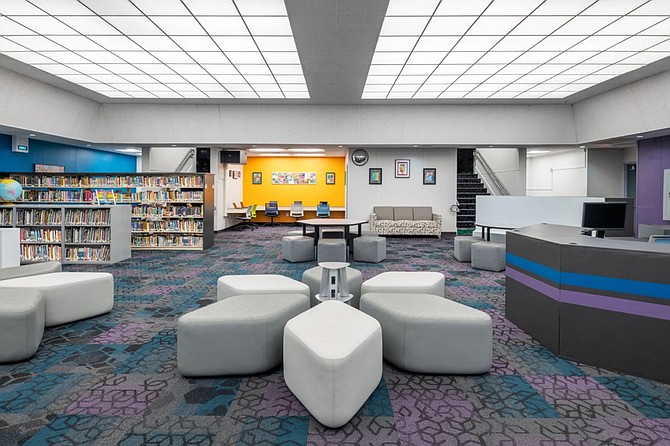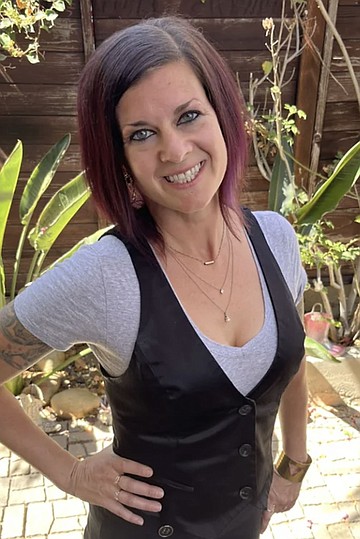 Facebook
Facebook
 X
X
 Instagram
Instagram
 TikTok
TikTok
 Youtube
Youtube

“McKinley Elementary’s library hadn’t been updated since 1970,” says interior designer Heather Vitti Pruett. “Fifty years!” Then, back in 2018, Pruett suddenly found herself in a position to do something about that, after she enrolled her daughter Riadon at the South Park school. “I decided that I wanted to get involved in the PTA, or PTC — Parent Teachers’ Club — and it just so happened that at my first PTC meeting, the principal announced the Beautification Committee was going to be doing a library remodel. I thought, ‘This is great. It’s right up my alley.’ So I went and talked to Deb [Ganderton, the then-principal of McKinley], and basically volunteered to take over the project.”

And she did. Except, if you listen to her, it seems the school’s kids were the ones who really took over. “First, I sat in the library and watched. I watched the kids come in, sit down. They couldn’t stay in one place, because the layout was just boring. There was no real interest. I talked with the teachers, I did questionnaires, I did interviews. I also wanted to get the kids’ perspective. So Deb sent out something to the other teachers, and soon kids aged 8-11 formed a student committee and volunteered! I said, ‘Let’s get concept images.’ Well, these kids found about 150 [library] images. I took them and separated them into categories of library design: architectural details, seating, storage/organization, book cases. The kids went around to each and every class, took all of these images to all of the classrooms, and we did what was called The School Votes. Every student, every teacher got to vote, down to kindergarten: ‘Which image do you like the best?’ They counted up the votes; I took the top three of each category, and used that in the implementation of the design.”
Cut for a two-year covid hiatus, and arrive at last year, when, with a new student library committee in place, Pruett took a second run at the project. “I came up with a PowerPoint presentation, where I talked about the principles of design, and it was really cool to see the kids using that. Everything that you see in there was selected by the kids: the carpet, the paint, the furniture. I treated them the same I would any other client. I brought them three different options of, for instance, flooring: purple, green, gray. The one that got installed was the one that they picked. From there, we went into teams. And the kids [took] the paint and the fabric, and they were holding them up against each other.”
It was all hands to the pump. She even painted the student-chosen octagonal circulation desk herself. Pruett says that her “we can do this” approach also drastically cut costs. Example: she actively wheeled and dealed with suppliers — Interface Carpet Company donated the carpet, Sherwin Williams gave them paint at half off — shamelessly sought and used parent volunteerism, and donated much of her own labor, working weekends for months. Result? “The projected budget was $200,000. We did it for $60,000.”
But did the effort make a difference? “I went back, on a library day, to see the kids in action. And they were really happy. They wanted to grab books, they wanted to sit at the cool furniture. And so they should. These kids helped design this library.”


“McKinley Elementary’s library hadn’t been updated since 1970,” says interior designer Heather Vitti Pruett. “Fifty years!” Then, back in 2018, Pruett suddenly found herself in a position to do something about that, after she enrolled her daughter Riadon at the South Park school. “I decided that I wanted to get involved in the PTA, or PTC — Parent Teachers’ Club — and it just so happened that at my first PTC meeting, the principal announced the Beautification Committee was going to be doing a library remodel. I thought, ‘This is great. It’s right up my alley.’ So I went and talked to Deb [Ganderton, the then-principal of McKinley], and basically volunteered to take over the project.”

And she did. Except, if you listen to her, it seems the school’s kids were the ones who really took over. “First, I sat in the library and watched. I watched the kids come in, sit down. They couldn’t stay in one place, because the layout was just boring. There was no real interest. I talked with the teachers, I did questionnaires, I did interviews. I also wanted to get the kids’ perspective. So Deb sent out something to the other teachers, and soon kids aged 8-11 formed a student committee and volunteered! I said, ‘Let’s get concept images.’ Well, these kids found about 150 [library] images. I took them and separated them into categories of library design: architectural details, seating, storage/organization, book cases. The kids went around to each and every class, took all of these images to all of the classrooms, and we did what was called The School Votes. Every student, every teacher got to vote, down to kindergarten: ‘Which image do you like the best?’ They counted up the votes; I took the top three of each category, and used that in the implementation of the design.”
Cut for a two-year covid hiatus, and arrive at last year, when, with a new student library committee in place, Pruett took a second run at the project. “I came up with a PowerPoint presentation, where I talked about the principles of design, and it was really cool to see the kids using that. Everything that you see in there was selected by the kids: the carpet, the paint, the furniture. I treated them the same I would any other client. I brought them three different options of, for instance, flooring: purple, green, gray. The one that got installed was the one that they picked. From there, we went into teams. And the kids [took] the paint and the fabric, and they were holding them up against each other.”
It was all hands to the pump. She even painted the student-chosen octagonal circulation desk herself. Pruett says that her “we can do this” approach also drastically cut costs. Example: she actively wheeled and dealed with suppliers — Interface Carpet Company donated the carpet, Sherwin Williams gave them paint at half off — shamelessly sought and used parent volunteerism, and donated much of her own labor, working weekends for months. Result? “The projected budget was $200,000. We did it for $60,000.”
But did the effort make a difference? “I went back, on a library day, to see the kids in action. And they were really happy. They wanted to grab books, they wanted to sit at the cool furniture. And so they should. These kids helped design this library.”
Comments